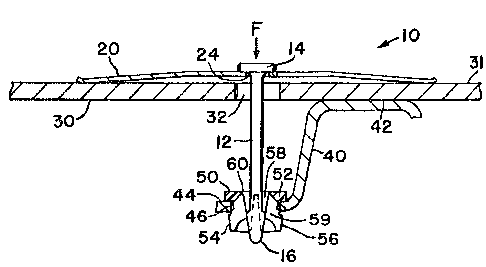Une partie des informations de ce site Web a été fournie par des sources externes. Le gouvernement du Canada n'assume aucune responsabilité concernant la précision, l'actualité ou la fiabilité des informations fournies par les sources externes. Les utilisateurs qui désirent employer cette information devraient consulter directement la source des informations. Le contenu fourni par les sources externes n'est pas assujetti aux exigences sur les langues officielles, la protection des renseignements personnels et l'accessibilité.
L'apparition de différences dans le texte et l'image des Revendications et de l'Abrégé dépend du moment auquel le document est publié. Les textes des Revendications et de l'Abrégé sont affichés :
| (12) Brevet: | (11) CA 1301081 |
|---|---|
| (21) Numéro de la demande: | 1301081 |
| (54) Titre français: | DISPOSITIF D'ARRET |
| (54) Titre anglais: | RETAINER ASSEMBLY |
| Statut: | Périmé et au-delà du délai pour l’annulation |
| (51) Classification internationale des brevets (CIB): |
|
|---|---|
| (72) Inventeurs : |
|
| (73) Titulaires : |
|
| (71) Demandeurs : |
|
| (74) Agent: | MACRAE & CO. |
| (74) Co-agent: | |
| (45) Délivré: | 1992-05-19 |
| (22) Date de dépôt: | 1988-04-22 |
| Licence disponible: | S.O. |
| Cédé au domaine public: | S.O. |
| (25) Langue des documents déposés: | Anglais |
| Traité de coopération en matière de brevets (PCT): | Non |
|---|
| (30) Données de priorité de la demande: | ||||||
|---|---|---|---|---|---|---|
|
RETAINER ASSEMBLY
ABSTRACT OF THE DISCLOSURE
The retainer assembly (10) comprises a longi-
tudinally extending retainer body (12) having an enlarged
diameter or head member (14) at one end and an arrow-
shaped or flared member (16) at the other end. A V-shaped
leaf spring (20) has an opening (24) at the bottom of the
V-shaped opening (22) which receives the retainer body
(12) so that the spring (20) is disposed between the head
member (14) and a surface (31) of a first member (30). The
retainer body (12) extends through an opening (32) in the
first member (30) and the flared member (16) is resili-
ently captured within a resilient receiving member (50)
disposed within an opening (46) of the second member (40).
The opening (46) in the second member (40) is in a second
surface (44) disposed apart from a first surface (42) of
the second member (40) which engages the first member
(30). The receiving member (50) flexibly traps the flared
member (16) after insertion therethrough so that the leaf
spring (20) biases the first member (30) into engagement
with the second member (40).
Note : Les revendications sont présentées dans la langue officielle dans laquelle elles ont été soumises.
Note : Les descriptions sont présentées dans la langue officielle dans laquelle elles ont été soumises.

2024-08-01 : Dans le cadre de la transition vers les Brevets de nouvelle génération (BNG), la base de données sur les brevets canadiens (BDBC) contient désormais un Historique d'événement plus détaillé, qui reproduit le Journal des événements de notre nouvelle solution interne.
Veuillez noter que les événements débutant par « Inactive : » se réfèrent à des événements qui ne sont plus utilisés dans notre nouvelle solution interne.
Pour une meilleure compréhension de l'état de la demande ou brevet qui figure sur cette page, la rubrique Mise en garde , et les descriptions de Brevet , Historique d'événement , Taxes périodiques et Historique des paiements devraient être consultées.
| Description | Date |
|---|---|
| Inactive : CIB de MCD | 2006-03-11 |
| Le délai pour l'annulation est expiré | 1997-05-20 |
| Lettre envoyée | 1996-05-20 |
| Accordé par délivrance | 1992-05-19 |
Il n'y a pas d'historique d'abandonnement
Les titulaires actuels et antérieures au dossier sont affichés en ordre alphabétique.
| Titulaires actuels au dossier |
|---|
| ALLIED-SIGNAL INC. |
| Titulaires antérieures au dossier |
|---|
| DONALD DIXON JOHANNESEN |
| ROBERT BRUCE TEMPLE |